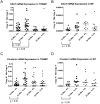Lack of evidence for green tea polyphenols as DNA methylation inhibitors in murine prostate
- PMID: 19934341
- PMCID: PMC2789312
- DOI: 10.1158/1940-6207.CAPR-09-0010
Lack of evidence for green tea polyphenols as DNA methylation inhibitors in murine prostate
Abstract
Green tea polyphenols (GTP) have been reported to inhibit DNA methylation in cultured cells. Here, we tested whether oral consumption of GTPs affects normal or cancer-specific DNA methylation in vivo, using mice. Wild-type (WT) and transgenic adenocarcinoma of mouse prostate (TRAMP) mice were given 0.3% GTPs in drinking water beginning at 4 weeks of age. To monitor DNA methylation, we measured 5-methyl-deoxycytidine (5mdC) levels, methylation of the B1 repetitive element, and methylation of the Mage-a8 gene. Each of these parameters were unchanged in prostate, gut, and liver from WT mice at both 12 and 24 weeks of age, with the single exception of a decrease of 5mdC in the liver at 12 weeks. In GTP-treated TRAMP mice, 5mdC levels and the methylation status of four loci hypermethylated during tumor progression were unaltered in TRAMP prostates at 12 or 24 weeks. Quite surprisingly, GTP treatment did not inhibit tumor progression in TRAMP mice, although known pharmacodynamic markers of GTPs were altered in both WT and TRAMP prostates. We also administered 0.1%, 0.3%, or 0.6% GTPs to TRAMP mice for 12 weeks and measured 5mdC levels and methylation of B1 and Mage-a8 in prostate, gut, and liver tissues. No dose-dependent alterations in DNA methylation status were observed. Genome-wide DNA methylation profiling using the HpaII tiny fragment enrichment by ligation-mediated PCR assay also revealed no significant hypomethylating effect of GTP. These data indicate that oral administration of GTPs does not affect normal or cancer-specific DNA methylation in the murine prostate.
Figures







Similar articles
-
Promoter demethylation and chromatin remodeling by green tea polyphenols leads to re-expression of GSTP1 in human prostate cancer cells.Int J Cancer. 2010 Jun 1;126(11):2520-33. doi: 10.1002/ijc.24988. Int J Cancer. 2010. PMID: 19856314 Free PMC article.
-
Inhibition of prostate carcinogenesis in TRAMP mice by oral infusion of green tea polyphenols.Proc Natl Acad Sci U S A. 2001 Aug 28;98(18):10350-5. doi: 10.1073/pnas.171326098. Epub 2001 Aug 14. Proc Natl Acad Sci U S A. 2001. PMID: 11504910 Free PMC article.
-
Prognostic significance of metastasis-associated protein S100A4 (Mts1) in prostate cancer progression and chemoprevention regimens in an autochthonous mouse model.Clin Cancer Res. 2005 Jan 1;11(1):147-53. Clin Cancer Res. 2005. PMID: 15671539
-
Green tea prevents non-melanoma skin cancer by enhancing DNA repair.Arch Biochem Biophys. 2011 Apr 15;508(2):152-8. doi: 10.1016/j.abb.2010.11.015. Epub 2010 Nov 19. Arch Biochem Biophys. 2011. PMID: 21094124 Free PMC article. Review.
-
Polyphenols as cancer chemopreventive agents.J Cell Biochem Suppl. 1995;22:169-80. doi: 10.1002/jcb.240590822. J Cell Biochem Suppl. 1995. PMID: 8538195 Review.
Cited by
-
DNA methylation profiling using HpaII tiny fragment enrichment by ligation-mediated PCR (HELP).Methods. 2010 Nov;52(3):218-22. doi: 10.1016/j.ymeth.2010.04.013. Epub 2010 Apr 29. Methods. 2010. PMID: 20434563 Free PMC article. Review.
-
Epigenetic activities of flavonoids in the prevention and treatment of cancer.Clin Epigenetics. 2015 Jul 10;7(1):64. doi: 10.1186/s13148-015-0095-z. eCollection 2015. Clin Epigenetics. 2015. PMID: 26161152 Free PMC article.
-
Impact of dietary gut microbial metabolites on the epigenome.Philos Trans R Soc Lond B Biol Sci. 2018 Jun 5;373(1748):20170359. doi: 10.1098/rstb.2017.0359. Philos Trans R Soc Lond B Biol Sci. 2018. PMID: 29685968 Free PMC article. Review.
-
Epigenetic and biogenetic regulation by polyphenols in prostate cancer in the context of 3P medicine.EPMA J. 2024 Dec 21;16(1):113-125. doi: 10.1007/s13167-024-00391-3. eCollection 2025 Mar. EPMA J. 2024. PMID: 39991103 Review.
-
Cancer chemoprevention by dietary polyphenols: promising role for epigenetics.Biochem Pharmacol. 2010 Dec 15;80(12):1771-92. doi: 10.1016/j.bcp.2010.06.036. Epub 2010 Jun 26. Biochem Pharmacol. 2010. PMID: 20599773 Free PMC article. Review.
References
-
- NCI. SEER Cancer Statistics Review 1975-2005. 2007
-
- Nelson PS, Montgomery B. Unconventional therapy for prostate cancer: good, bad or questionable? Nat Rev Cancer. 2003;3:845–58. - PubMed
-
- Nelson WG, Yegnasubramanian S, Agoston AT, et al. Abnormal DNA methylation, epigenetics, and prostate cancer. Front Biosci. 2007;12:4254–66. - PubMed
-
- Gronbaek K, Hother C, Jones PA. Epigenetic changes in cancer. APMIS. 2007;115:1039–59. - PubMed
-
- Ghoshal K, Bai S. DNA methyltransferases as targets for cancer therapy. Drugs Today (Barc) 2007;43:395–422. - PubMed
Publication types
MeSH terms
Substances
Grants and funding
LinkOut - more resources
Full Text Sources
Medical

